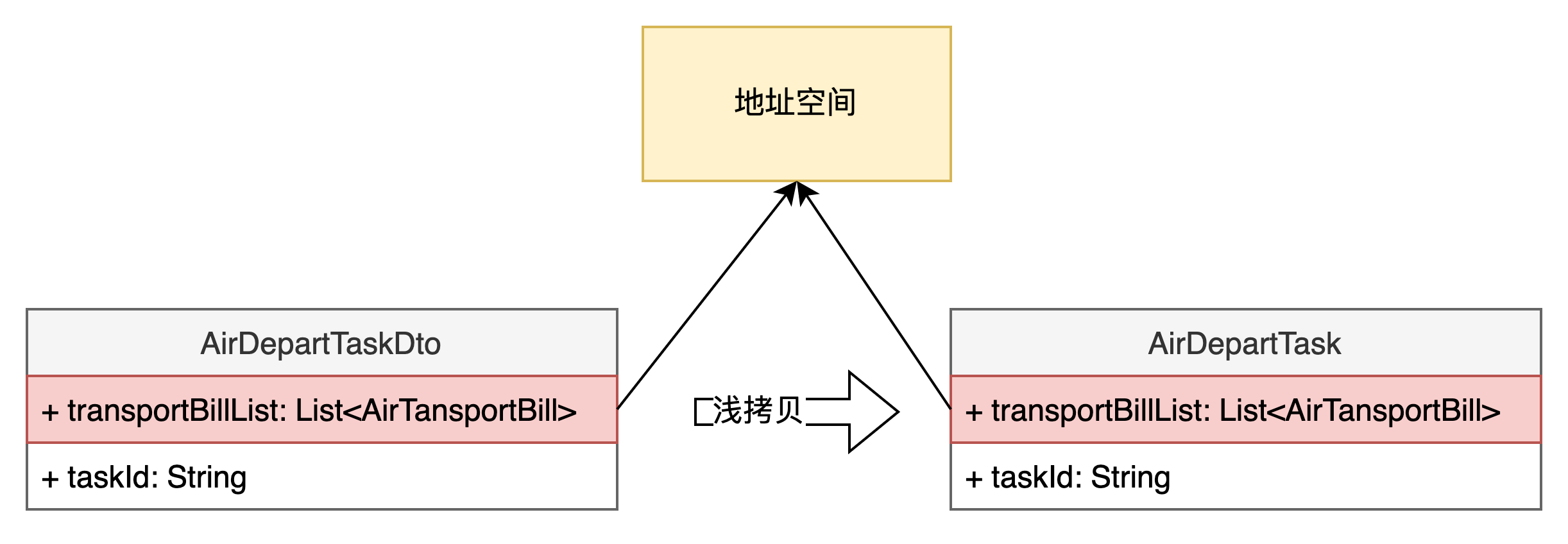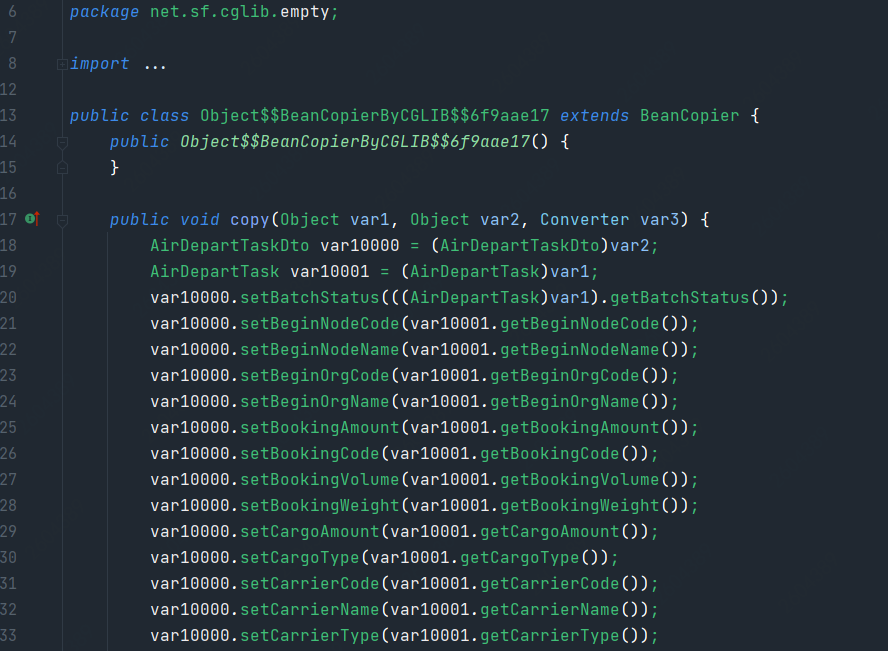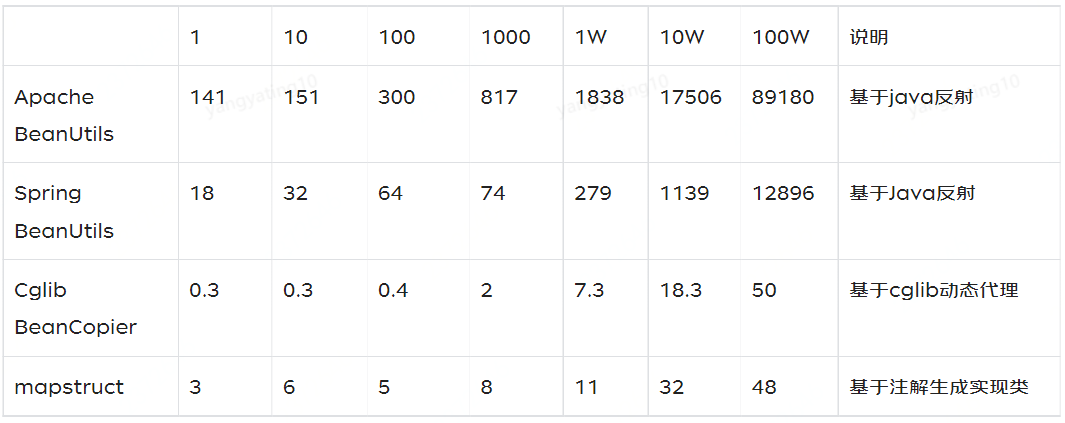
作者:宁海翔
对象拷贝,是我们在开发过程中,绕不开的过程,既存在于 Po、Dto、Do、Vo 各个表现层数据的转换,也存在于系统交互如序列化、反序列化。
Java 对象拷贝分为深拷贝和浅拷贝,目前常用的属性拷贝工具,包括 Apache 的 BeanUtils、Spring 的 BeanUtils、Cglib 的 BeanCopier、mapstruct 都是浅拷贝。
深拷贝:对基本数据类型进行值传递,对引用数据类型,创建一个新的对象,并复制其内容称为深拷贝。
深拷贝常见有以下四种实现方式:

浅拷贝:对基本数据类型进行值传递,对引用数据类型进行引用传递般的拷贝称为浅拷贝。通过实现 Cloneabe 接口并重写 Object 类中的 clone() 方法可以实现浅克隆。

目前常用的属性拷贝工具,包括 Apache 的 BeanUtils、Spring 的 BeanUtils、Cglib 的 BeanCopier、mapstruct。
2.1.1 Apache BeanUtils
使用方式:BeanUtils.copyProperties(target, source);
BeanUtils.copyProperties 对象拷贝的核心代码如下:
// 1.获取源对象的属性描述
PropertyDescriptor[] origDescriptors = this.getPropertyUtils().getPropertyDescriptors(orig);
PropertyDescriptor[] temp = origDescriptors;
int length = origDescriptors.length;
String name;
Object value;
// 2.循环获取源对象每个属性,设置目标对象属性值
for(int i = 0; i < length; ++i) {
PropertyDescriptor origDescriptor = temp[i];
name = origDescriptor.getName();
// 3.校验源对象字段可读切目标对象该字段可写
if (!"class".equals(name) && this.getPropertyUtils().isReadable(orig, name) && this.getPropertyUtils().isWriteable(dest, name)) {
try {
// 4.获取源对象字段值
value = this.getPropertyUtils().getSimpleProperty(orig, name);
// 5.拷贝属性
this.copyProperty(dest, name, value);
} catch (NoSuchMethodException var10) {
}
}
}
循环遍历源对象的每个属性,对于每个属性,拷贝流程为:
由于单字段拷贝时每个阶段都会调用 PropertyUtilsBean.getPropertyDescriptor 获取属性配置,而该方法通过 for 循环获取类的字段属性,严重影响拷贝效率。
获取字段属性配置的核心代码如下:
PropertyDescriptor[] descriptors = this.getPropertyDescriptors(bean);
if (descriptors != null) {
for (int i = 0; i < descriptors.length; ++i) {
if (name.equals(descriptors[i].getName())) {
return descriptors[i];
}
}
}
使用方式: BeanUtils.copyProperties(source, target);
BeanUtils.copyProperties 核心代码如下:
PropertyDescriptor[] targetPds = getPropertyDescriptors(actualEditable);
List<String> ignoreList = ignoreProperties != null ? Arrays.asList(ignoreProperties) : null;
PropertyDescriptor[] arr$ = targetPds;
int len$ = targetPds.length;
for(int i$ = 0; i$ < len$; ++i$) {
PropertyDescriptor targetPd = arr$[i$];
Method writeMethod = targetPd.getWriteMethod();
if (writeMethod != null && (ignoreList == null || !ignoreList.contains(targetPd.getName()))) {
PropertyDescriptor sourcePd = getPropertyDescriptor(source.getClass(), targetPd.getName());
if (sourcePd != null) {
Method readMethod = sourcePd.getReadMethod();
if (readMethod != null && ClassUtils.isAssignable(writeMethod.getParameterTypes()[0], readMethod.getReturnType())) {
try {
if (!Modifier.isPublic(readMethod.getDeclaringClass().getModifiers())) {
readMethod.setAccessible(true);
}
Object value = readMethod.invoke(source);
if (!Modifier.isPublic(writeMethod.getDeclaringClass().getModifiers())) {
writeMethod.setAccessible(true);
}
writeMethod.invoke(target, value);
} catch (Throwable var15) {
throw new FatalBeanException("Could not copy property '" + targetPd.getName() + "' from source to target", var15);
}
}
}
}
}
拷贝流程简要描述如下:
与 Apache BeanUtils 的属性拷贝相比,Spring 通过 Map 缓存,避免了类的属性描述重复获取加载,通过懒加载,初次拷贝时加载所有属性描述。

2.1.3 Cglib BeanCopier
使用方式:
BeanCopier beanCopier = BeanCopier.create(AirDepartTask.class, AirDepartTaskDto.class, false);
beanCopier.copy(airDepartTask, airDepartTaskDto, null);
create 调用链如下:
BeanCopier.create
-> BeanCopier.Generator.create
-> AbstractClassGenerator.create
->DefaultGeneratorStrategy.generate
-> BeanCopier.Generator.generateClass
BeanCopier 通过 cglib 动态代理操作字节码,生成一个复制类,触发点为 BeanCopier.create

2.1.4 mapstruct
使用方式:
mapstruct 基于注解,构建时自动生成实现类,调用链如下:
MappingProcessor.process -> MappingProcessor.processMapperElements
MapperCreationProcessor.process:生成实现类 Mapper
MapperRenderingProcessor:将实现类 mapper,写入文件,生成 impl 文件
使用时需要声明转换接口,例如:
@Mapper(nullValuePropertyMappingStrategy = NullValuePropertyMappingStrategy.IGNORE)
public interface AirDepartTaskConvert {
AirDepartTaskConvert INSTANCE = getMapper(AirDepartTaskConvert.class);
AirDepartTaskDto convertToDto(AirDepartTask airDepartTask);
}
生成的实现类如下:
public class AirDepartTaskConvertImpl implements AirDepartTaskConvert {
@Override
public AirDepartTaskDto convertToDto(AirDepartTask airDepartTask) {
if ( airDepartTask == null ) {
return null;
}
AirDepartTaskDto airDepartTaskDto = new AirDepartTaskDto();
airDepartTaskDto.setId( airDepartTask.getId() );
airDepartTaskDto.setTaskId( airDepartTask.getTaskId() );
airDepartTaskDto.setPreTaskId( airDepartTask.getPreTaskId() );
List<String> list = airDepartTask.getTaskBeginNodeCodes();
if ( list != null ) {
airDepartTaskDto.setTaskBeginNodeCodes( new ArrayList<String>( list ) );
}
// 其他属性拷贝
airDepartTaskDto.setYn( airDepartTask.getYn() );
return airDepartTaskDto;
}
}
以航空业务系统中发货任务 po 到 dto 转换为例,随着拷贝数据量的增大,研究拷贝数据耗时情况

经过以上分析,随着数据量的增大,耗时整体呈上升趋势
使用时可以使用 map 缓存,减少同一类对象转换时,create 次数
/**
* BeanCopier的缓存,避免频繁创建,高效复用
*/
private static final ConcurrentHashMap<String, BeanCopier> BEAN_COPIER_MAP_CACHE = new ConcurrentHashMap<String, BeanCopier>();
/**
* BeanCopier的copyBean,高性能推荐使用,增加缓存
*
* @param source 源文件的
* @param target 目标文件
*/
public static void copyBean(Object source, Object target) {
String key = genKey(source.getClass(), target.getClass());
BeanCopier beanCopier;
if (BEAN_COPIER_MAP_CACHE.containsKey(key)) {
beanCopier = BEAN_COPIER_MAP_CACHE.get(key);
} else {
beanCopier = BeanCopier.create(source.getClass(), target.getClass(), false);
BEAN_COPIER_MAP_CACHE.put(key, beanCopier);
}
beanCopier.copy(source, target, null);
}
/**
* 不同类型对象数据copylist
*
* @param sourceList
* @param targetClass
* @param <T>
* @return
*/
public static <T> List<T> copyListProperties(List<?> sourceList, Class<T> targetClass) throws Exception {
if (CollectionUtils.isNotEmpty(sourceList)) {
List<T> list = new ArrayList<T>(sourceList.size());
for (Object source : sourceList) {
T target = copyProperties(source, targetClass);
list.add(target);
}
return list;
}
return Lists.newArrayList();
}
/**
* 返回不同类型对象数据copy,使用此方法需注意不能覆盖默认的无参构造方法
*
* @param source
* @param targetClass
* @param <T>
* @return
*/
public static <T> T copyProperties(Object source, Class<T> targetClass) throws Exception {
T target = targetClass.newInstance();
copyBean(source, target);
return target;
}
/**
* @param srcClazz 源class
* @param tgtClazz 目标class
* @return string
*/
private static String genKey(Class<?> srcClazz, Class<?> tgtClazz) {
return srcClazz.getName() + tgtClazz.getName();
}
mapstruct 支持多种形式对象的映射,主要有下面几种
@Mapper(nullValuePropertyMappingStrategy = NullValuePropertyMappingStrategy.IGNORE)
public interface AirDepartTaskConvert {
AirDepartTaskConvert INSTANCE = getMapper(AirDepartTaskConvert.class);
// a.基本映射
@Mapping(target = "createTime", source = "updateTime")
// b.映射表达式
@Mapping(target = "updateTimeStr", expression = "java(new SimpleDateFormat( \"yyyy-MM-dd\" ).format(airDepartTask.getCreateTime()))")
AirDepartTaskDto convertToDto(AirDepartTask airDepartTask);
}
@Mapper
public interface AddressMapper {
AddressMapper INSTANCE = Mappers.getMapper(AddressMapper.class);
// c.多个对象映射到一个对象
@Mapping(source = "person.description", target = "description")
@Mapping(source = "address.houseNo", target = "houseNumber")
DeliveryAddressDto personAndAddressToDeliveryAddressDto(Person person, Address address);
}
@Mapper
public interface CarMapper {
// d.映射集合
Set<String> integerSetToStringSet(Set<Integer> integers);
List<CarDto> carsToCarDtos(List<Car> cars);
CarDto carToCarDto(Car car);
// e.映射map
@MapMapping(valueDateFormat = "dd.MM.yyyy")
Map<String,String> longDateMapToStringStringMap(Map<Long, Date> source);
// f.映射枚举
@ValueMappings({
@ValueMapping(source = "EXTRA", target = "SPECIAL"),
@ValueMapping(source = "STANDARD", target = "DEFAULT"),
@ValueMapping(source = "NORMAL", target = "DEFAULT")
})
ExternalOrderType orderTypeToExternalOrderType(OrderType orderType);
// g.嵌套映射
@Mapping(target = "fish.kind", source = "fish.type")
@Mapping(target = "fish.name", ignore = true)
@Mapping(target = "ornament", source = "interior.ornament")
@Mapping(target = "material.materialType", source = "material")
@Mapping(target = "quality.report.organisation.name", source = "quality.report.organisationName")
FishTankDto map( FishTank source );
}
以上就是我在使用对象拷贝过程中的一点浅谈。在日常系统开发过程中,要深究底层逻辑,哪怕发现一小点的改变能够使我们的系统更加稳定、顺畅,都是值得我们去改进的。
最后,希望随着我们的加入,系统会更加稳定、顺畅,我们会变得越来越优秀。
